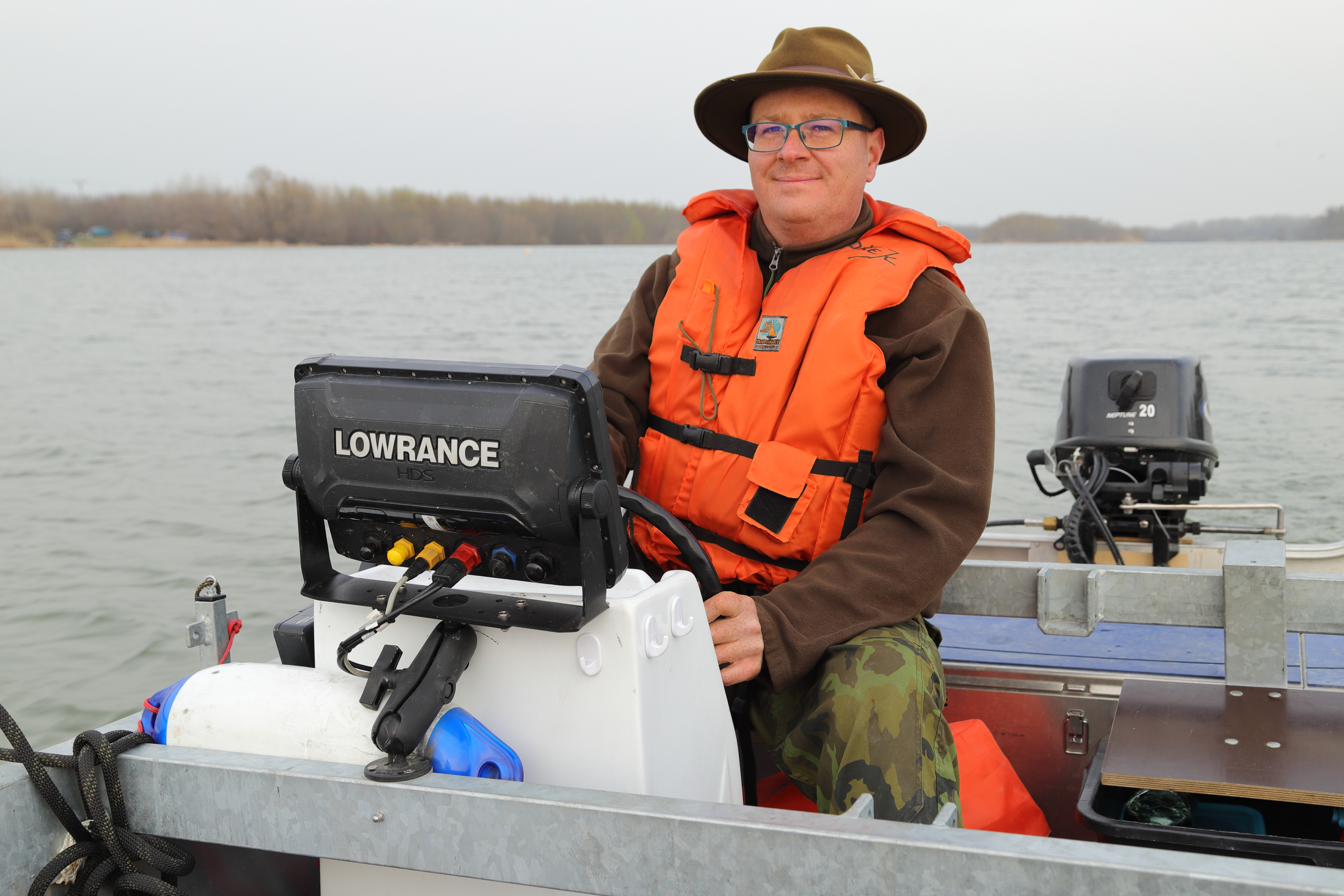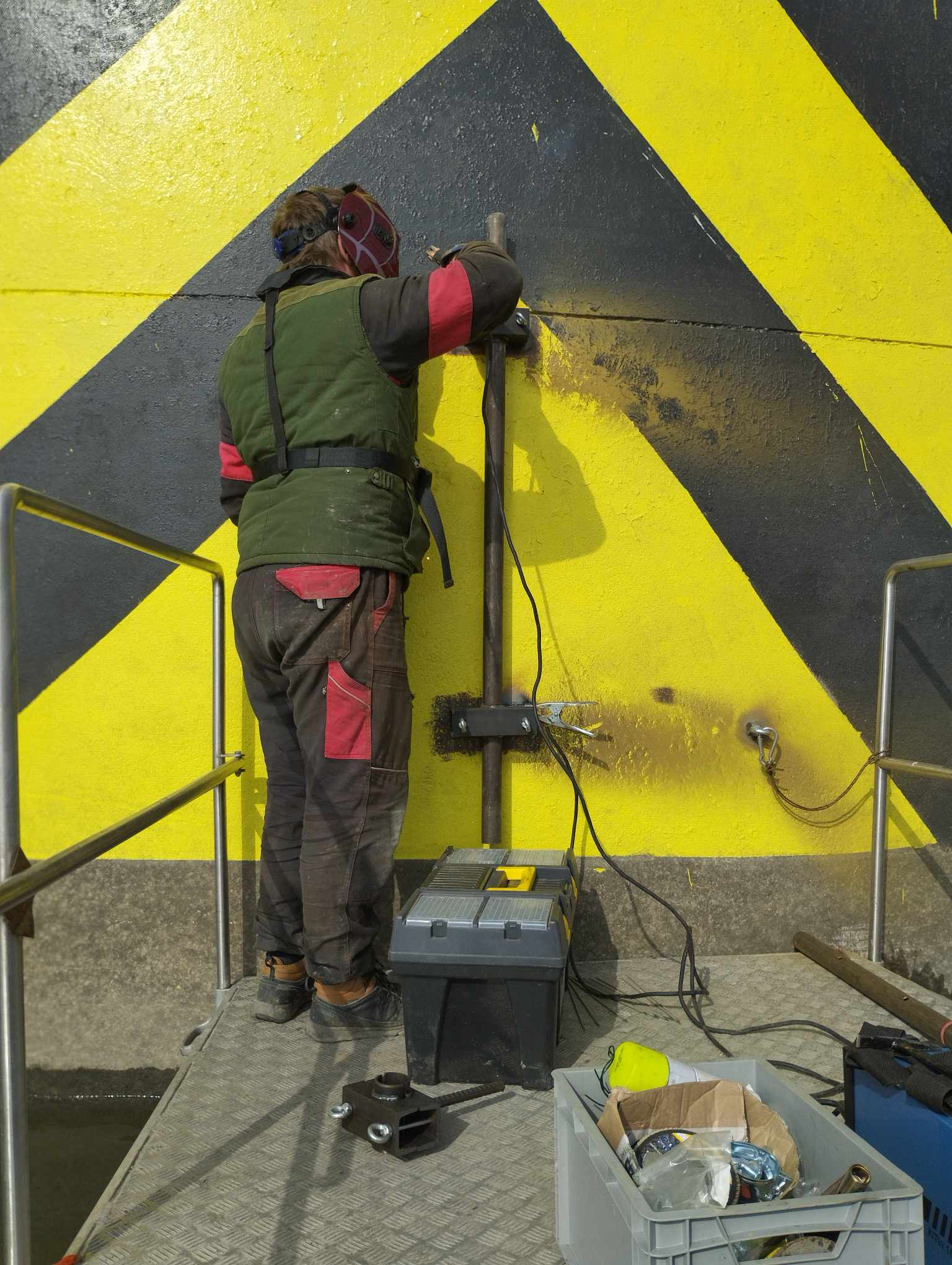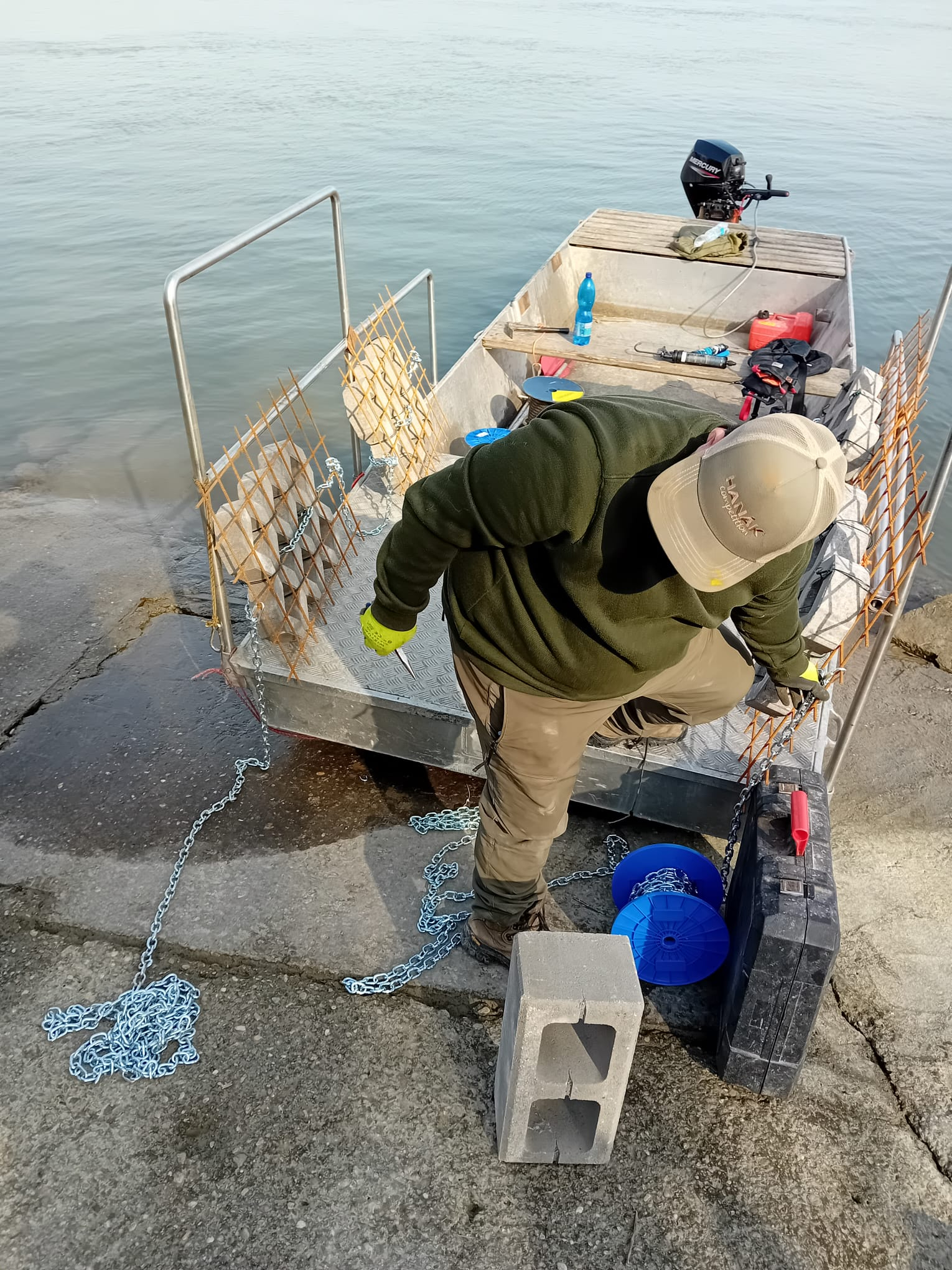On October 20th–29th, 2024, FFPW USB staff (Bořek Drozd, Filip Ložek, Pavel Staněk, Martin Šindler) together with students of the faculty, employees of the Slovak Angling Union and members of the Slovak Fishing Club caught and tagged 3 rheophilic fish species for a telemetry study aimed at determining the current migratory passability of Slovak - Hungarian parts of the Danube for fish. The target fish species are: sterlet (Acipenser ruthenus) as the flagship fish species of the Danube basin, as well as barbel (Barbus barbus) and asp (Leuciscus aspius). The activity took place within the framework of fulfilling the goals of the integrated project LIFE Living Rivers (101069837/LIFE21-IPE-SK-Living Rivers).
RNDr. Bořek Drozd, Ph.D.
On September 10-11, 2024, FFPW USB staff (Bořek Drozd, Martin Šindler) performed adjustment and service of the telemetry gates installed on water structures and in free-flowing passages in the Slovak-Hungarian part of the Danube in order to determine the migration activity of the sterlet (Acipenser ruthenus) in the project area of the integrated LIFE project Living Rivers (101069837/LIFE21-IPE-SK-Living Rivers).
Written by: RNDr. Bořek Drozd, Ph.D.
On February 25-29, 2024, FFPW USB staff (Bořek Drozd, Jan Kubec, Lukáš Veselý, Filip Ložek, Martin Vlk) carried out the second phase of installing telemetry gates to monitor the movement of rheophilic fish species in the Slovak part of the Danube in the project area of the LIFE Living Rivers project (101069837/LIFE21-IPE-SK-Living Rivers).
RNDr. Bořek Drozd, Ph.D.
On January 6-10, 2025, the staff of the FFPW USB (Bořek Drozd, Filip Ložek, Lukáš Veselý, Jan Kubec, Martin Vlk, Filip Kupka, Pavel Staněk, Daniel Kvapil) downloaded data from telemetric gates installed on water structures and in free-flowing passages in the Slovak-Hungarian part of the Danube in order to determine the migratory activity of the sterlet (Acipenser ruthenus), asp (Leuciscus aspius) and barb (Barbus barbus) in the project area of the integrated LIFE project Living Rivers (101069837/LIFE21-IPE-SK-Living Rivers). In addition, new telemetric gates were installed, and maintenance, service and repair of the installed telemetric equipment were performed.
Written by: RNDr. Bořek Drozd, Ph.D.
On August 26-29, 2024, FFPW USB staff (Bořek Drozd, Jan Kubec, Martin Vlk) performed dowmloading of data from telemetry gates installed on water structures and in free-flowing passages in the Slovak-Hungarian part of the Danube in order to determine the migration activity of the sterlet (Acipenser ruthenus) in the project area of the integrated LIFE project Living Rivers (101069837/LIFE21-IPE-SK-Living Rivers). Furthermore, maintenance, service and repair of the installed telemetry equipment was carried out.
Written by: RNDr. Bořek Drozd, Ph.D.
On 11th March 2025, FFPW USB staff (Bořek Drozd, Filip Ložek, Martin Šindler) checked telemetry gates installed on water structures and free-flowing passages in the Slovak-Hungarian part of the Danube River in the project area of the integrated LIFE project Living Rivers (101069837/LIFE21-IPE-SK-Living Rivers). Furthermore, a new method for collecting fish larvae using passive ichthyoplankton nets was calibrated.
Written by: RNDr. Bořek Drozd, Ph.D.
Eradication of the first red swamp crayfish population in Slovakia
Four members of the Faculty of Fisheries and Protection of Water USB (Antonín Kouba, Augusto Frederico Huber, Jakub Kocour, and Alex Pavlinců) participated in a targeted eradication program against the first known population of the highly invasive red swamp crayfish in Slovakia (discovered in May 2023). Its population occurs in the upper stretch of the Čepčínský brook located near Turčianské Teplice. The main eradication campaign that happened on September 11 combined several approaches and resulted in more than 4,600 individuals eliminated. More details about the invaded site can be found in our recently publishedarticle.
From 6th to 8th November 2024, a meeting of limnologists took place at the Water Research Institute in Bratislava as part of a course on identification of stonefly larvae. The course was led by Dr. Matej Žiak and supplemented with comments from other participants. The introductory lecture was about the distribution, conservation, and ecology of stoneflies in Slovakia and the Czech Republic. In the subsequent sessions, participants were thoroughly introduced to the new identification key for larvae of Slovakia. The course concluded with the identification of participants' own material.
FFPW USB CENAKVA actively participates in the international monitoring of the Danube - The Joint Danube Survey 5 (JDS5)
FFPW USB CENAKVA is an active member of a broad international consortium (14 countries) that cooperates in one of the world's most extensive water environment monitoring programs - The Joint Danube Survey 5 (JDS5), which is focused on comprehensive monitoring of the Danube and its major tributaries. In the period May 24th -30th. 2025, our sampling team, consisting of T. Randák, R. Grabic (FFPW JU CENAKVA), and B. Vrana (MU Brno RECETOX), successfully installed passive samplers at 8 locations in the middle and lower reaches of the Danube. During our seven-day trip, we covered 3700 km, visited seven countries, and experienced many interesting situations.
- Fotogalerie:
- Foto:
 , Text k fotce:
Prohlídka rybí farmy Biely Potok, Slovryb, a.s. – opatření k zlepšení welfare ryb při nedostatku vody v letních měsících
, Text k fotce:
Prohlídka rybí farmy Biely Potok, Slovryb, a.s. – opatření k zlepšení welfare ryb při nedostatku vody v letních měsících - Foto:
 , Text k fotce:
Zemní rybník s generačním hejnem lipanů, SRZ Rada, o.z. – středisko Svit
, Text k fotce:
Zemní rybník s generačním hejnem lipanů, SRZ Rada, o.z. – středisko Svit - Foto:
 , Text k fotce:
Moderní semirecirkulační objekt s chovem pstruha duhového, SRZ Rada, o.z. – středisko Svit
, Text k fotce:
Moderní semirecirkulační objekt s chovem pstruha duhového, SRZ Rada, o.z. – středisko Svit - Foto:
 , Text k fotce:
Zařízení na výrobu kyslíku ze vzduchu k oxigenaci nádrží s rybami. Jedná se o nízkotlaký systém (10 l O2/min.) s nízkou spotřebou elektrické energie.
, Text k fotce:
Zařízení na výrobu kyslíku ze vzduchu k oxigenaci nádrží s rybami. Jedná se o nízkotlaký systém (10 l O2/min.) s nízkou spotřebou elektrické energie. - Foto:
 , Text k fotce:
Rybí líheň MO SRZ Martin, kde se vytírá nejstarší chovné hejno hlavatky podunajské na Slovensku
, Text k fotce:
Rybí líheň MO SRZ Martin, kde se vytírá nejstarší chovné hejno hlavatky podunajské na Slovensku - Foto:
 , Text k fotce:
Rybník „hruška“ původně určený k odchovu generačních hlavatek podunajských na farmě Príbovce, dnes slouží k odchovu reofilních druhů ryb a lipanů, SRZ Rada, o.z.
, Text k fotce:
Rybník „hruška“ původně určený k odchovu generačních hlavatek podunajských na farmě Príbovce, dnes slouží k odchovu reofilních druhů ryb a lipanů, SRZ Rada, o.z. - Foto:
 , Text k fotce:
Farma fy. Petra Aqua s chovem akvarijních ryb v Turčianských Tepliciach
, Text k fotce:
Farma fy. Petra Aqua s chovem akvarijních ryb v Turčianských Tepliciach - Foto:
From 22nd to 24th January 2025, we participated (Regenda, Like, Niksirat) in a working trip to Slovakia in the framework of which the conclusions of the project BYCZ-SPF00088 Fish Welfare Education – Knowledge Transfer and Innovation in Fisheries Science, which is supported by the Small Project Fund of the Interreg Bavaria-Czech Republic Programme, were presented. The workshop programme focused on the demonstration of different fish farming technologies within Slovak aquaculture and the possibilities of addressing fish welfare issues. The event's partners from the Czech Republic, Germany, and Slovakia shared their experiences with fish welfare issues. A total of eight different fish farms were visited.

- Fotogalerie:
- Foto:
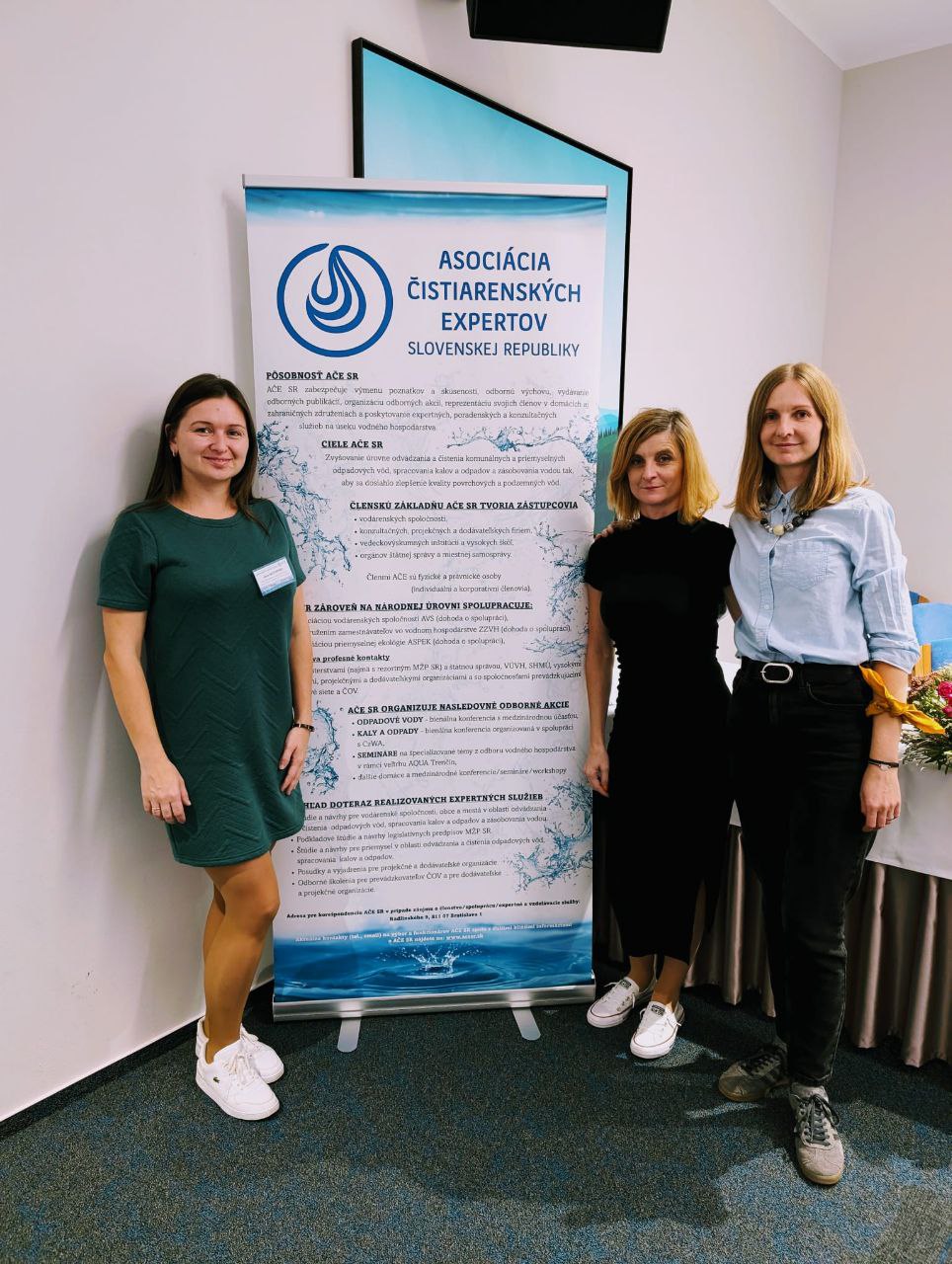
The conference " WASTEWATER 2024" took place from October 16 to 18, 2024, in Štrbské Pleso, High Tatras, Slovakia. Vojs Staňová Andrea successfully presented the methods for removing micropollutants from wastewater. Fedorova Ganna and Sadchenko Alina presented their research in the poster session, focusing on wastewater reuse in aquaculture and agriculture.
The conference provided an excellent opportunity to exchange knowledge with colleagues and establish valuable professional connections. The presented research received positive feedback, confirming the high quality of our group's scientific work.
- Fotogalerie:
- Foto:
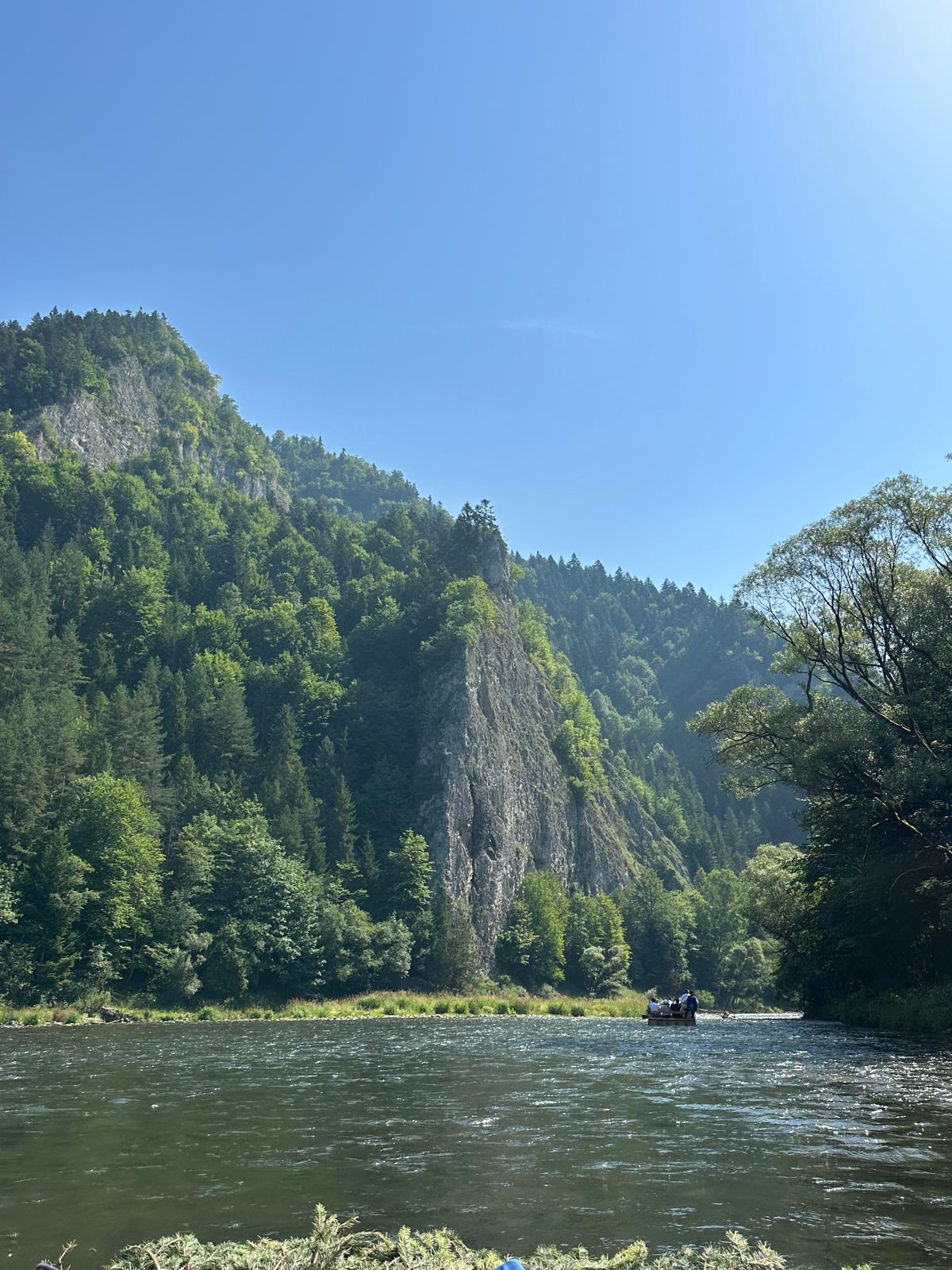
- Foto:

From July 7thto 12th, 2024, the 4th Central European Symposium for Aquatic Macroinvertebrate Research (CESAMIR) was held in Stará Lesná, Slovakia. The symposium brought together over 100 participants from 20 countries and featured 69 oral presentations, four plenary lectures, and 45 poster presentations across various sessions. These sessions covered topics such as diversity, biogeography, invasive species, and conservation.
During the conference, Natalia Szydłowska presented a poster titled "Macroinvertebrates under pressure: Can a Ponto-Caspian invader affect them more than a native?" Her research focused on the diet and feeding preferences of the invasive round goby Neogobius melanostomus (Pallas, 1814) and the native European bullhead Cottus gobio Linnaeus, 1758 in the Ploučnice River, where both species co-occur. Her work earned her the "Best Student Poster Prize" awarded by the Scientific Committee, which included complimentary participation in a scientific training course organized by Physalia.
The symposium was organized by the Plant Science and Biodiversity Centre, Slovak Academy of Sciences. The book of abstracts is available here.
- Fotogalerie:
- Foto:

On November 19-20, 2024, we participated in the Neogiant project meeting in Madrid, Spain. During the discussions, we talked about the progress in individual work packages and project management, as well as communication strategies.
There was also a discussion regarding closer collaboration with the CENAKVA center and the potential expansion of our activities. We gained valuable insights that will help us optimize our future cooperation.
On November 5–6, 2024, a representative of the CENAKVA, FFPW JU, Vladimír Žlábek, attended the 4th Assembly of Beneficiaries meeting and the 8thSteering Committee meeting of the DANUBIUS-RI Implementation Phase (HORIZON) project in Barcelona (Universitat Politècnica de Catalunya). The meeting agenda included a review of the progress in implementing the legal entity Danubius – ERIC and the coordination of activities within the DANUBIUS-RI project.
- Fotogalerie:
- Foto:
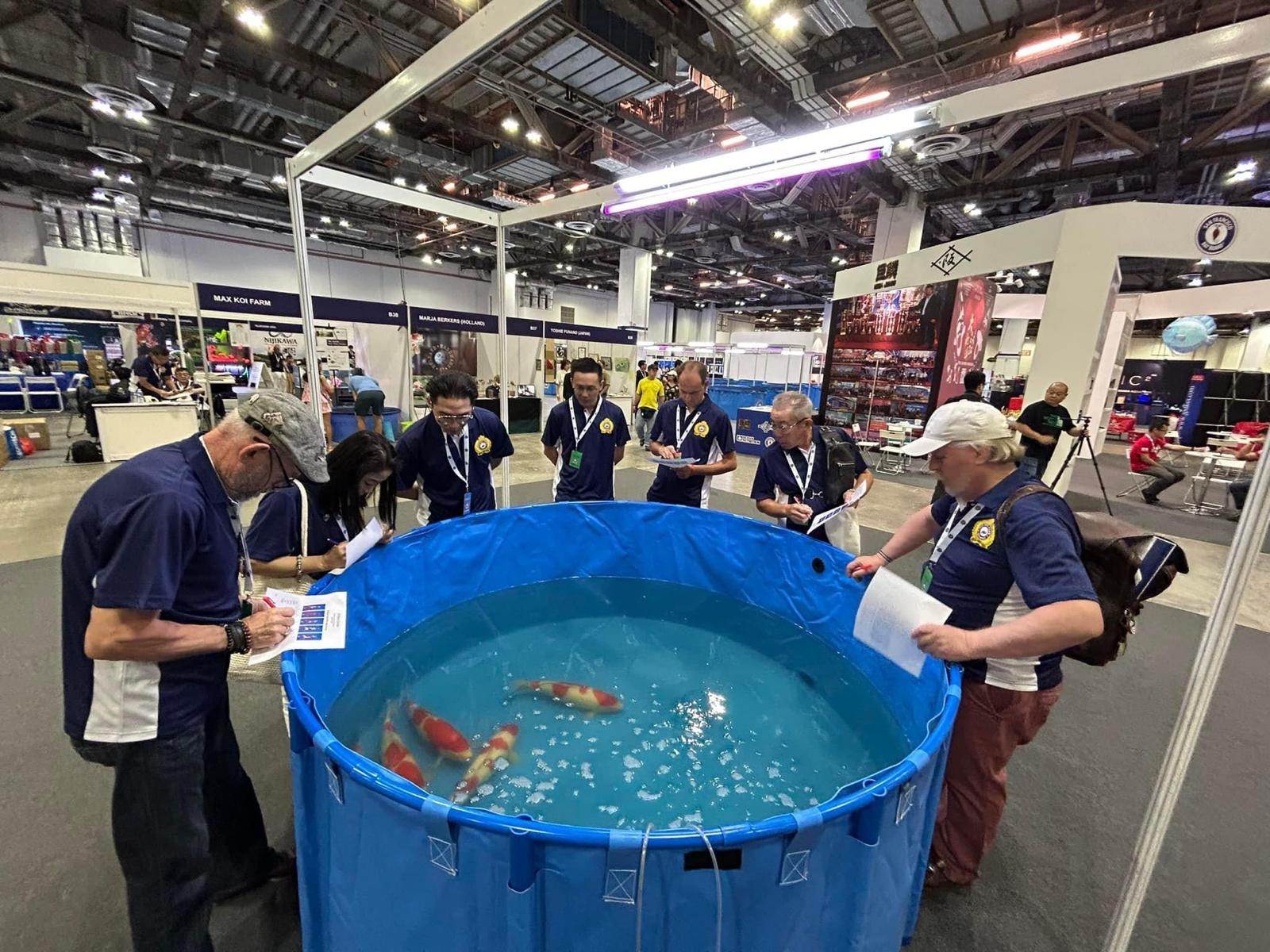
From 16 July - 23 July 2024, I participated in the 15th Asia Koi Cup at the Aquatic and Garden Asia Show where I presided as an assistant judge for the Asia Cup Koi Carp Quality Assessment at Marina Bay Sands in Singapore. After the said event, I subsequently chaired one Koi section at the World Aquaculture Symposium. During this symposium I saw some very interesting talks on technological innovation in aquaculture. At the same time, I also presented an overview lecture on the aquaculture and teaching activities of the Faculty of Fisheries and Aquatic Protection of the University of South Bohemia in České Budějovice (FFPW USB). The aforementioned stay in Singapore, including participation in the largest scientific research event of its kind in the whole of Southeast Asia, was a great and beneficial experience and opportunity, which will be further used at the Faculty of Fisheries and Protection of Waters USB to develop teaching Bc., Mgr. D. and Ph.D. students and research dealing with species and technological diversification of freshwater aquaculture.
Written by: Pavel Svoboda
Through the Erasmus+ mobility funding program, I participated in several training activities at the Feed Technology Laboratory, Swedish University of Agricultural Sciences, Sweden. Specifically, I participated in instruction about the operation of aquafeed production and in feed production, including mixing materials, extruding, drying, and oil coating. In addition, I visited a fish experimental facility and shared knowledge about insects as feed during a seminar at the receiving institute.
During an inspiring scientific visit to the Hochschule für Agrar-, Forst- und Lebensmittelwissenschaften (HAFL), we had the exciting opportunity to collaborate on cutting-edge research in sustainable aquaculture. A key highlight was the hands-on sampling of European perch (Perca fluviatilis), where we gathered crucial data on growth performance and health indicators. Our main focus is to explore the potential of replacing traditional fishmeal with mycelium-based protein sources, aiming for a more sustainable and nutritious diet. We collected biological samples for biochemical and molecular analyses to investigate their anti-inflammatory properties and overall impact on fish health. This visit sparked dynamic interdisciplinary discussions, fuelling innovation and new ideas for the future of eco-friendly aquaculture.
Between 5th and 8th November 2024, Hung Quang Tran and Vlastimil Stejskal visited Aquaforum at the School of Agricultural, Forest, and Food Sciences, Bern University of Applied Sciences, Switzerland. During this period, we engaged in various collaborative activities, including biometric assessments for European perch for an upcoming experiment, as well as discussions on the progress of an ongoing project investigating novel protein ingredients for aquatic animals.
I participated in VIV Asia, an international event dedicated to animal protein production and its associated sectors, held in Bangkok, Thailand, as well as Vietshrimp, a platform that brings together stakeholders to discuss and explore solutions for the sustainable development of the shrimp industry, held in Can Tho, Vietnam. In addition to attending these events, I conducted visits to several institutions and companies engaged in aquaculture research. In Thailand, these included the Faculty of Fisheries at Kasetsart University, the Asian Institute of Technology (AIT), the Center of Excellence in Shrimp Molecular Biology and Biotechnology at Mahidol University, and PC Farm Thailand. In Vietnam, I visited the College of Aquaculture and Fisheries at Can Tho University and Shrimpvet. This trip was supported by AD Aquaculture Nutrition and Prince Edward Island, Canada, under funding number 202501-41.
In May 2025, Paride Balzani was at Muğla Sıtkı Koçman University (Turkey) for a teaching and research visit. During this time, he gave two seminars: „Biological Invasions and Ecosystem Disruption: Causes, Consequences, and Challenges“ and „Introduction to functional response experiments“, and performed functional response experiments on the invasive blue crab (Callinectes sapidus).

